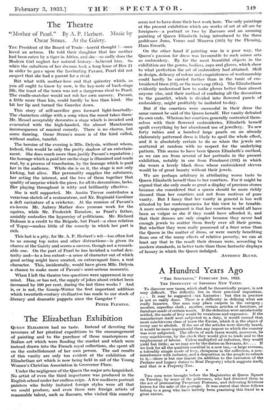The Elizabethan Exhibition
QUEEN ELIZABETH had no taste. Instead of devoting the revenues of her piratical expeditions to the encouragement of painting and to the purchase of those masterpieces of Italian art which were flooding the market and which were instead drawn into the French royal collections, she spent all on the embellishment of her own person. The sad results of this vanity are only too evident at the exhibition of Elizabethan art which is now being held in aid of the Young Women's Christian Association in Grosvenor Place.
Under the negligence of the Queen the major arts languished. No artist of even the third importance was produced in the English school under her endless reign. A few mediocre portrait painters who feebly imitated foreign styles were all that we could produce, and even those rare foreign artists' of reasonable talent, such as Zuccaro, who visited this country seem not to have done their best work here. The only paintings at the present exhibition which are works of art at all are by foreigners—a portrait or two by Zuccaro and an amusing painting of Queen Elizabeth being introduced to the three goddesses Juno, Venus and Minerva (105) by the Fleming, Hans Eworth.
On the other hand if painting was in a poor way, the Queen's passion for dress was favourable to such minor arts as embroidery. By far the most beautiful objects in the exhibition are the gowns, bodices, caps and gloves, which show to what perfection the art of embroidery had attained. Skill in design, delicacy of colour and exquisiteness of workmanship could hardly be carried further than in the tunic of em- broidered linen (92), or the man's cap (93a). The Elizabethans evidently understood how to make gloves better than almost anyone else, and their method of confining all the decoration to the gauntlet, which is divided into flowered panels of embroidery, might profitably be imitated to-day.
But if the courtiers were successful in their dress the same cannot be said of the Queen herself. Her vanity defeated its own ends. Whereas her courtiers generally contented them- selves with their flowered embroideries, Elizabeth herself spoilt everything by her abandoned use of jewellery. To sew forty rubies and a hundred large pearls on an already elaborately patterned dress is likely to spoil the whole effect, and it is absolutely certain to do so when the jewels are scattered at random with no respect for the underlying pattern. This seems to have been Queen Elizabeth's method, as we can see from several of her portraits in the present exhibition, notably in one from Penshurst (192) in which she wears a lovely black dress whose embroidered sleeves would be of great beauty without their jewels.
We are perhaps arbitrary in attributing worse taste to Queen Elizabeth herself than to her courtiers. For it might be argued that she only made so great a display of precious stones because she considered that a queen should be more richly dressed than her courtiers and not from motives of pure vanity. But I fancy that her vanity in general is too well attested by her contemporaries for this view to be tenable. A more serious argument is that her courtiers would all have been as vulgar as she if they could have afforded it, and that their dresses are only simpler because they never had enough jewels to scatter them freely over all their gowns. But whether they were really possessed of a finer sense than the Queen in the matter of dress, or were merely benefiting from one of the many effects of relative poverty, we can at least say that in the result their dresses were, according to modern standards, in better taste than those fantastic displays of luxury in which the Queen indulged.
ANTHONY BLUNT.




































 Previous page
Previous page